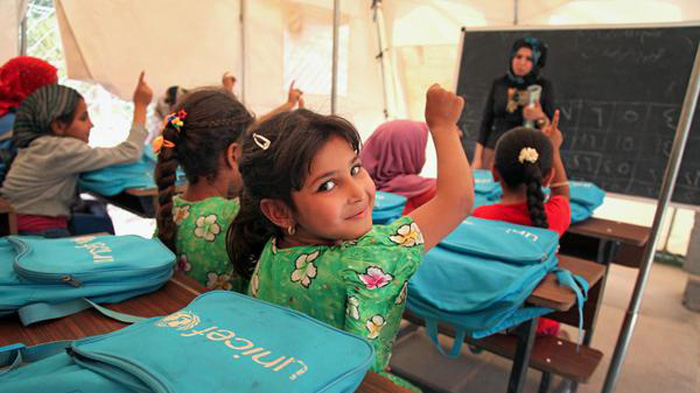GORDON BROWN
In a confrontational world where protectionism is on the rise, multilateralism has become an easy target for criticism. But those who doubt its value must have short memories. They seem to have forgotten that the Marshall Plan rebuilt Europe after World War II, NATO kept nuclear war at bay during the Cold War, and foreign aid lifted millions of people out of poverty in just the past few decades.
At the World Bank and the IMF’s upcoming annual spring meetings in Washington, DC, delegates will be reinforcing the case for international cooperation. In particular, we will be discussing the International Finance Facility for Education (IFFEd), a bold plan to ensure that, for the first time in history, all of the world’s 1.6 billion boys and girls – including refugees and displaced children in low- and middle-income countries – are in school and learning.
The IFFEd draws its inspiration from two landmark examples of international cooperation: the joint IMF-World Bank Heavily Indebted Poor Countries Initiative, which wiped out $100 billion in unpayable debt; and the Global Fund to Fight AIDS, Tuberculosis, and Malaria, which has saved millions of lives by providing immunizations and other services.
The IFFEd, for its part, would facilitate annual investments in education to the tune of nearly $10 billion. With these resources, we can make significant progress toward the United Nations Sustainable Development Goal for education, which aims to make primary and secondary education available for all children by 2030.
The quest for universal education is the civil-rights struggle of our age. After years of international neglect, 260 million children are not in school, and 400 million children are functionally illiterate. If current trends persist, by 2030, more than 800 million young people – half of the world’s youths – will leave school without the basic skills necessary for the modern labor market. And, by 2050, higher education will be available for 80% of young people in Korea, Japan, and Taiwan, but for no more than 10% of young people in Sub-Saharan African countries.
The need for expanded investment in education is even more urgent for girls and young women. Putting girls in school is the most effective way to keep them free from exploitation, forced labor, trafficking, and child marriage. Moreover, whereas educated women bear an average of two children, the average for uneducated women is five. This higher birth rate for uneducated women creates a vicious cycle. As illiterate young women have more children, average per capita income falls, and those children, having also missed out on an education, must increasingly migrate in search of opportunities elsewhere.
And yet, despite all of the good work being done by multilateral organizations such as the Global Partnership for Education and the new Education Cannot Wait Fund, total education aid has fallen in recent years. From 2010 to today, total funding for education in low- and lower-middle-income countries from bilateral aid and international donors fell from a paltry $10 per child to $8 per child. That is barely enough to pay for the cheapest textbook, let alone teachers and school buildings. Worse still, in response to recent pleas for education aid in conflict zones such as Chad, South Sudan, and Gambia, just 2% of the requested sum was raised.
As a result, by 2030, a majority of school-age teenagers in certain countries could be out of school and on the streets. Having been deprived of a curriculum that teaches them valuable skills and respect for different viewpoints, they will become ever more vulnerable to extremist groups that are counting on the West not to keep its promises.
The IFFEd is being launched with a challenge not only to donor countries, but also to the 47 lower-middle-income countries that are home to nearly half of the world’s schoolchildren. Developing countries and donors will enter into a compact in which each has a specific role to play to ensure that education is made available for all children.
Under this arrangement, each developing country will commit to achieving education outcomes commensurate with those of the current top 25% of countries, and to increasing the proportion of national income invested in education to 5.8%, from the current average of 4%. In return, donor countries will increase the share of funds for education in their foreign-aid budgets from the current average of 10% to 15%. They will also backstop development loans from the World Bank and regional development banks.
Even in 2030, the world’s poorest countries will not be able to afford around half of their total education costs. So, rather than having to borrow at interest rates of 3.5-4% to pay for teachers’ salaries, lower-middle-income countries will benefit from a new system of guarantees and low-interest or interest-free credits. And, by providing for lower-middle-income countries, we will be able to provide more direct grants for the 200 million children living in low-income countries.
Using as collateral the $150 billion of reflows from loans made in the 1970s and 1980s, we can increase the World Bank’s capacity to provide grants through its International Development Association. If we also divert a larger share of IDA contributions toward education, we can increase the education-aid funds available annually to the poorest countries from $1.6 billion (as of 2016) to more than $4 billion by 2020.
This up-front investment in education would extend the opportunity for a better life to more people than ever before. It would boost employment, slow population growth, and reduce infant and maternal mortality. And, as shown in the Learning Generation report, by 2050, GDP per capita in low-income countries would be 70% higher. Most important, it would provide hope to the millions of children who need it the most.
* Gordon Brown, former Prime Minister and Chancellor of the Exchequer of the United Kingdom, is United Nations Special Envoy for Global Education.







Comments